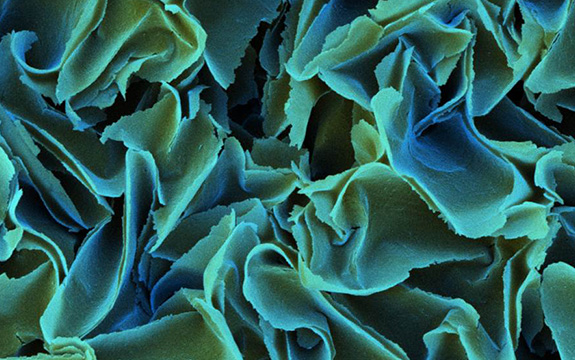Shining a light on Alzheimer’s disease

In Summary
- This article featured in Swinburne’s new ‘Research Impact’ magazine, produced in association with Nature Publishing Group.
With dementia now the second leading cause of death in Australia, Melbourne scientists have taken inspiration from some of nature’s smallest creatures to help solve an enormous problem.
A team led by Swinburne researchers has developed surfaces with features measuring billionths of a metre that mimic the extraordinary textured surface of insect wings. Their unique response to light makes these surfaces highly effective sensors, able to detect markers of disease at extremely low concentrations.
Swinburne Professor of Nanophotonics, Saulius Juodkazis, has developed nanotextured surface technology that is being used in proof-of-principle studies to look for biomarkers associated with Alzheimer’s disease, the most common form of dementia. It is projected that diagnosed cases of dementia in Australia will reach almost 950,000 by 2050, according to Alzheimer’s Australia.
No tests for biomarkers have been validated and Alzheimer’s is currently diagnosed through observations of a patient’s mental decline, by which stage the disease is already well established. Among the goals of scientists in the field is to develop simple and accurate tests that can detect early signs of the disease before symptoms appear. Their hope is that early detection will allow treatments to significantly slow progression of the disease.
Light fantastic
Professor Juodkazis has long been interested in the relationships between light and materials. Since earning his doctorate in experimental physics and material science from Vilnius University in Lithuania and Lyon-I University in France, in 1997, he has studied the mechanisms and applications of interactions between light and matter in many different settings.
After joining Swinburne University of Technology in 2009, he established an Applied Plasmonics research group to find industrial applications in the fields of nanotechnology and nanophotonics.
In 2011, his group joined an international collaboration that created a version of aluminium 40 per cent denser than metal in its normal form, using an extremely short laser pulse to create a huge concentration of energy in a tiny crystal composed of aluminium oxide.
“Using this focused laser technique, we may now be able to create a range of superdense metals that have extraordinary properties,” Professor Juodkazis told Asian Scientist magazine during the collaboration. “The creation of superdense silver or gold, for example, could lead to many new possibilities for bio-sensing and plasmonics.”
In 2012, he and colleagues collaborated with laser physicist Professor Esa Jaatinen from Queensland University of Technology on another application of light, creating a prototype sensor to detect chemicals that are present in many explosives.
The story of the prototype’s development was the focus of media reports that described the sensor as being based on a one-millimetre square corrugated gold surface that picks up traces of explosives floating in the air. Laser light shone on to the surface is altered in a particular way depending on the nature of the explosive chemical.
Also in 2012, Juodkazis established the Nano-Lab, Swinburne’s nanofabrication facility in the class-1000 cleanroom of the university’s $100 million Advanced Technologies Centre, an architecturally innovative and environmentally sustainable building that houses $40 million worth of world-class research infrastructure.
Detecting disease
The inspiration for the Alzheimer’s biomarker work emerged when Swinburne biotechnologist Professor Elena Ivanova reproduced the pattern found on dragonfly wings on a silicon surface. Professor Juodkazis found the surface had an unusual effect on light.
A dragonfly’s wing is covered with spikes a couple of hundred nanometres tall and tens of nanometres in diameter. While the surface scatters light so effectively that it appears black to the naked eye, at the nanoscopic level, the picture looks quite different. “When you shine light on that surface, light is scattered all directions, but locally there will be places where intensity is much higher,” says Professor Juodkazis.
When light waves are squeezed into nanoscale spaces they concentrate to an incredibly high intensity — up to a thousand times higher, he says. This super-high intensity light ‘floats’ on the material’s surface, a bit like a liquid.
Professor Juodkazis realised this property could be harnessed to look for molecules, even at very low concentrations. Once a molecule crosses into one of the light hotspots, the energy of the light will be scattered in a unique pattern — a tell-tale signature of that particular molecule.
The researchers have used this approach to test for beta amyloid, a biomarker of Alzheimer’s disease, at extremely low concentrations. Using a synthetic beta amyloid, Professor Juodkazis and colleagues showed that a nanotextured surface made with sapphire could detect the molecule at the sort of concentrations found in the spinal fluid of individuals with early-stage Alzheimer’s disease.
Professor Juodkazis has also found nanotextured silicon surfaces to be good sensors. The beauty of nanotextured silicon, or ‘black silicon’, is that it’s relatively cheap and easy to manufacture, using a technique known as plasma etching. During this process, a ‘mask’ covers most of the surface of the material before a stream of plasma etches a pattern on the area not covered by the mask. With nanotextured silicon, however, etching is allowed to happen randomly, without a mask to guide the stream of plasma. As the plasma etches away the surface, nanoscale islands of residue build up and protect the underlying silicon, while the silicon around those islands is etched away, leaving the spiky structure. “It’s really random and self-organised, and that’s why it is not expensive,” says Professor Juodkazis.
And because the nanotextured surface is so effective at scattering light, it could also have military applications in making surfaces appear invisible, he says.

